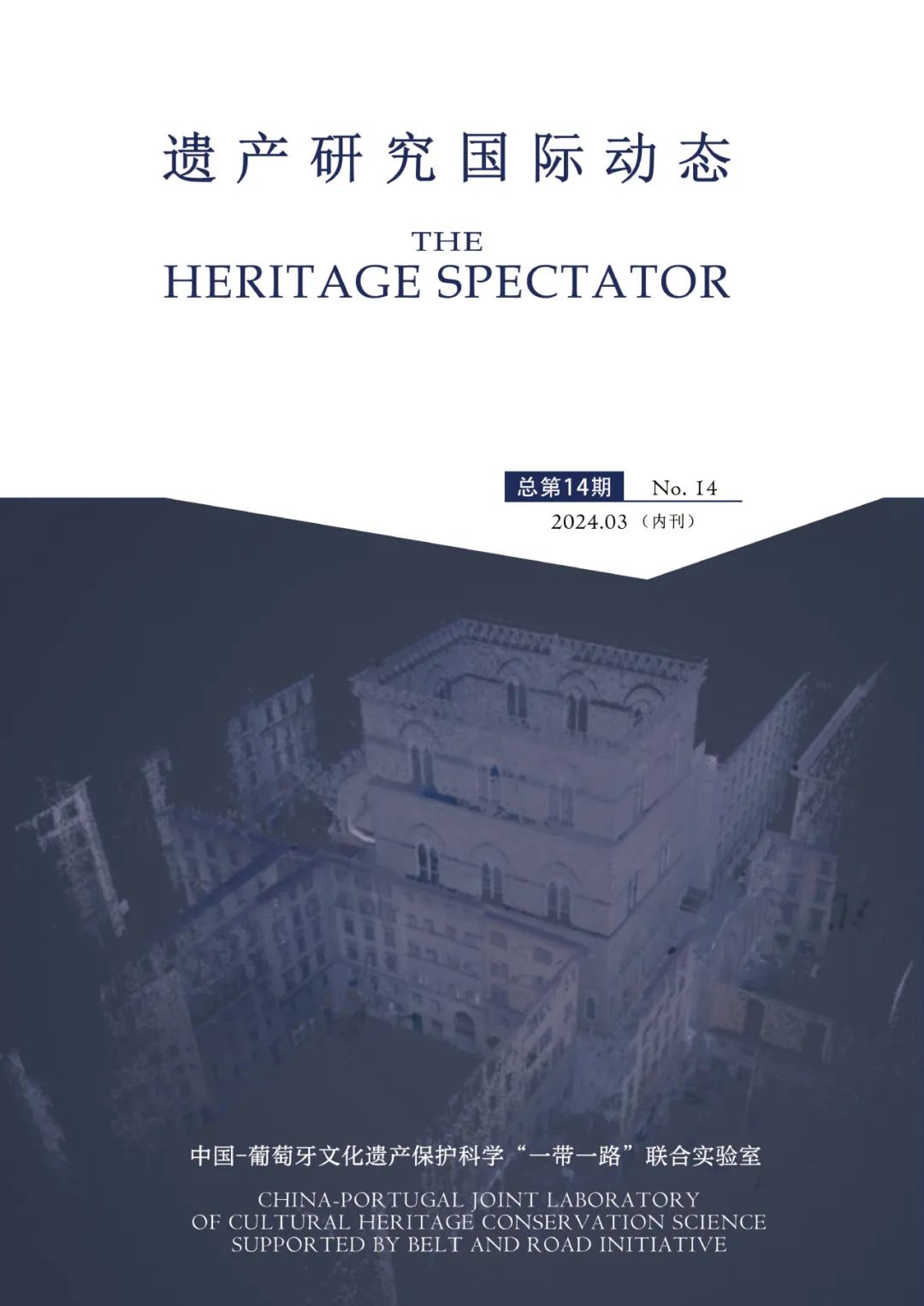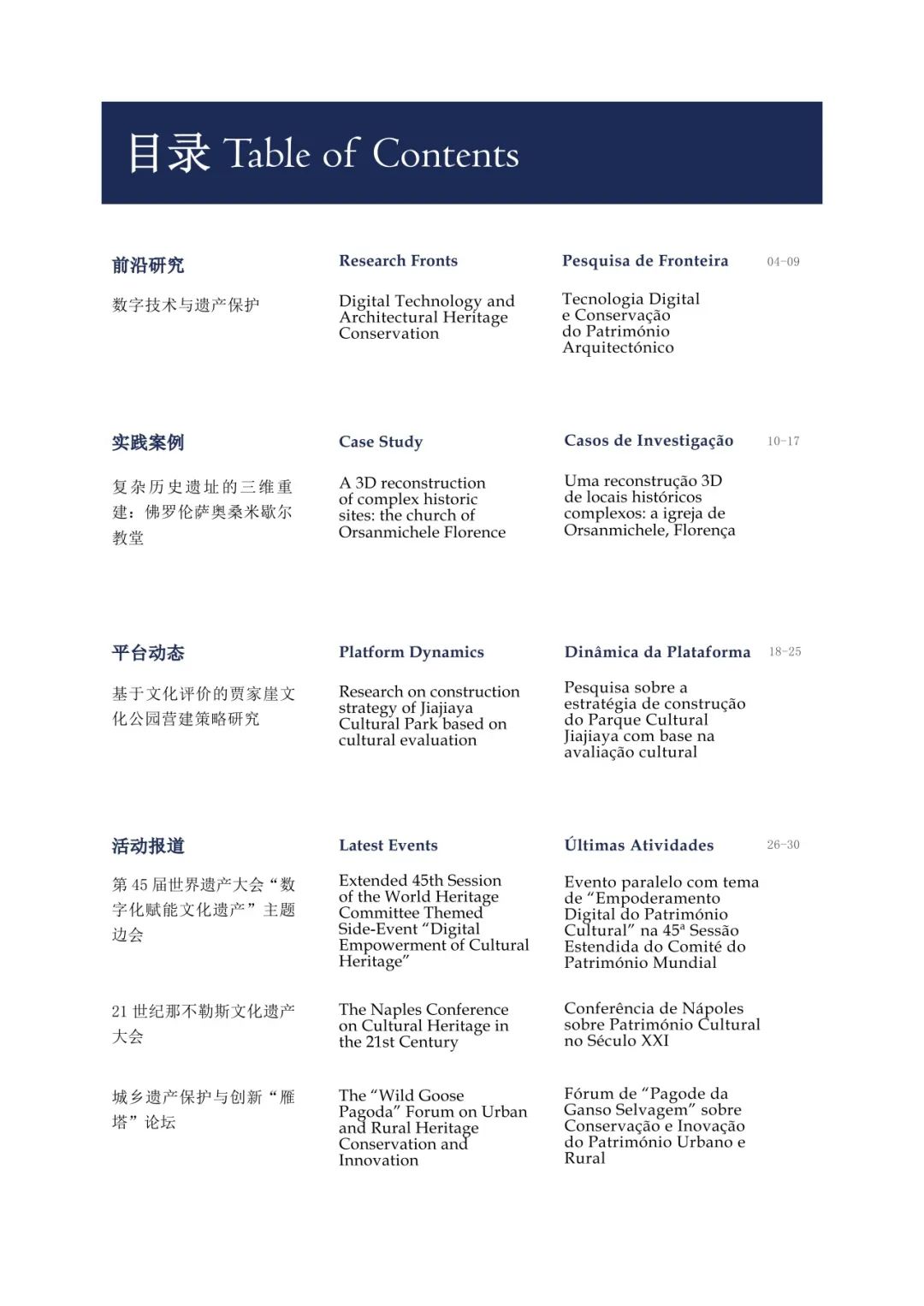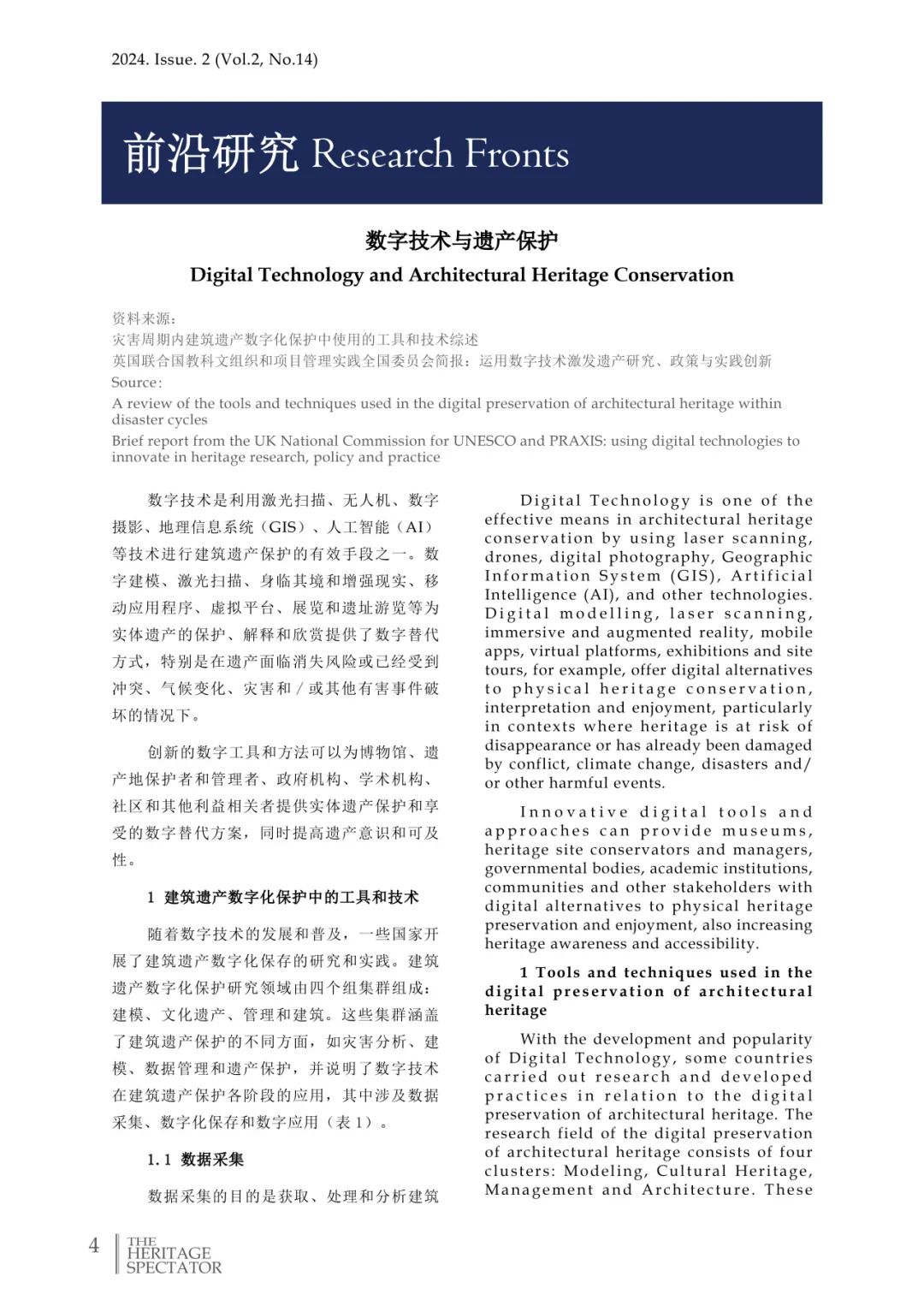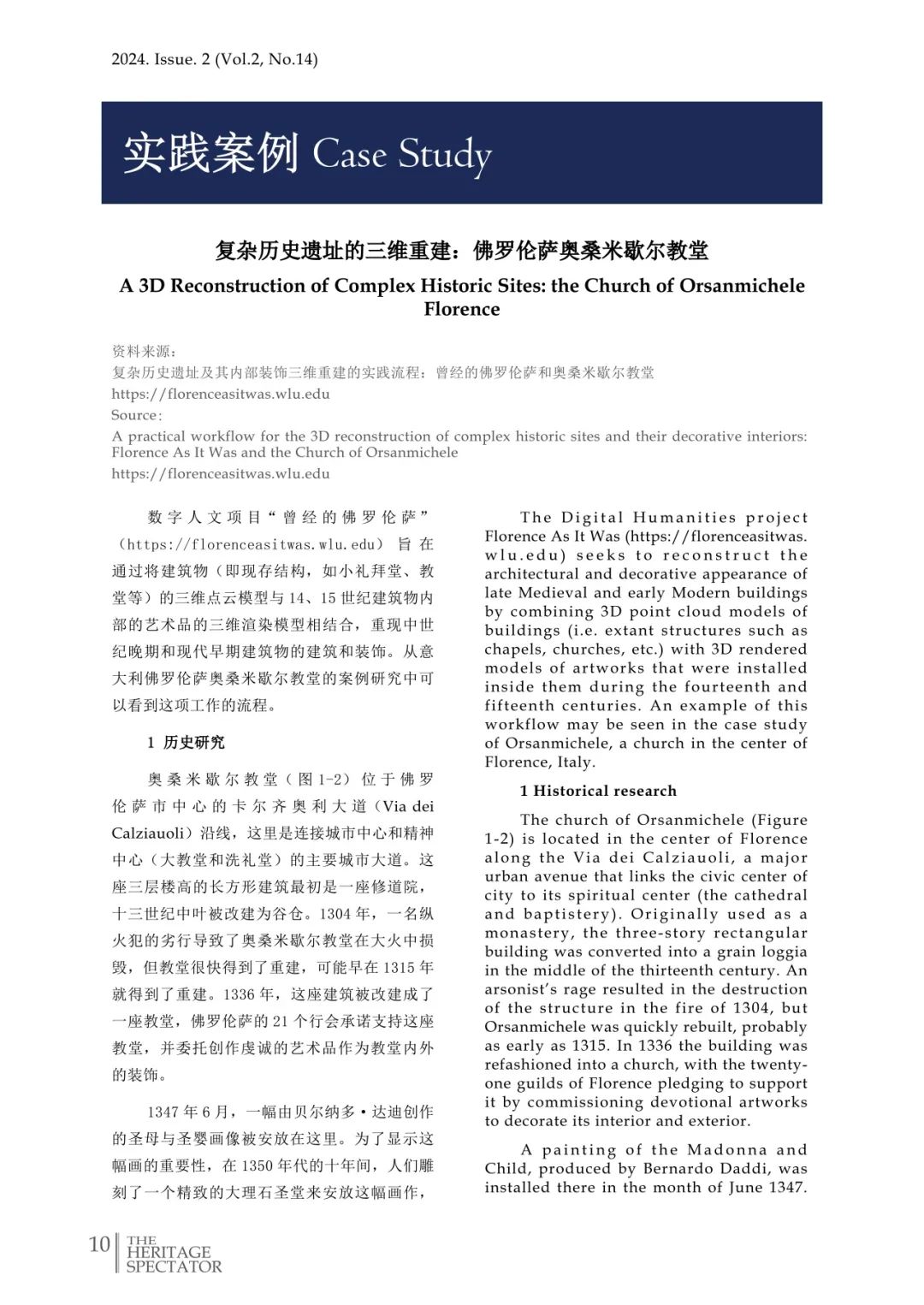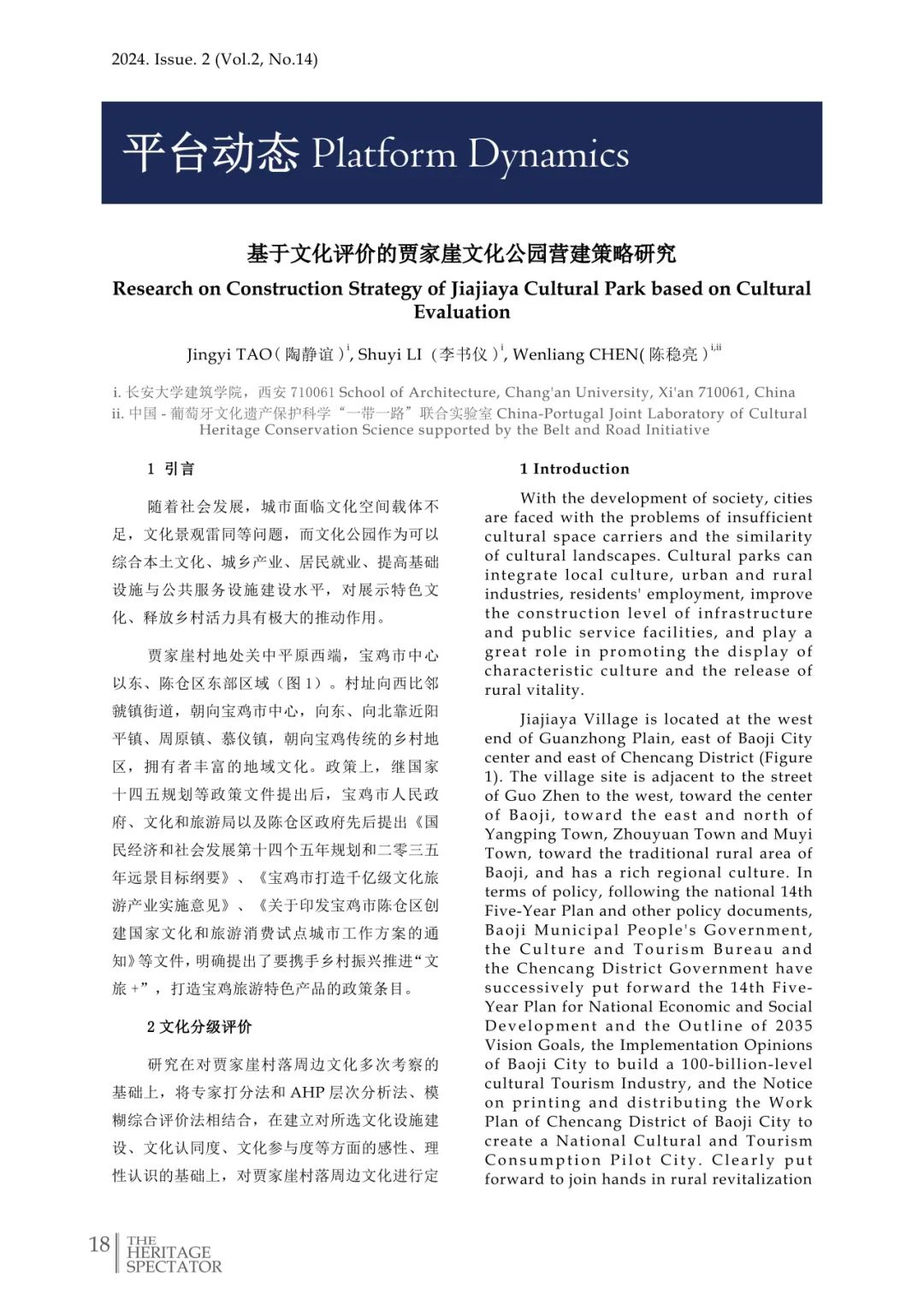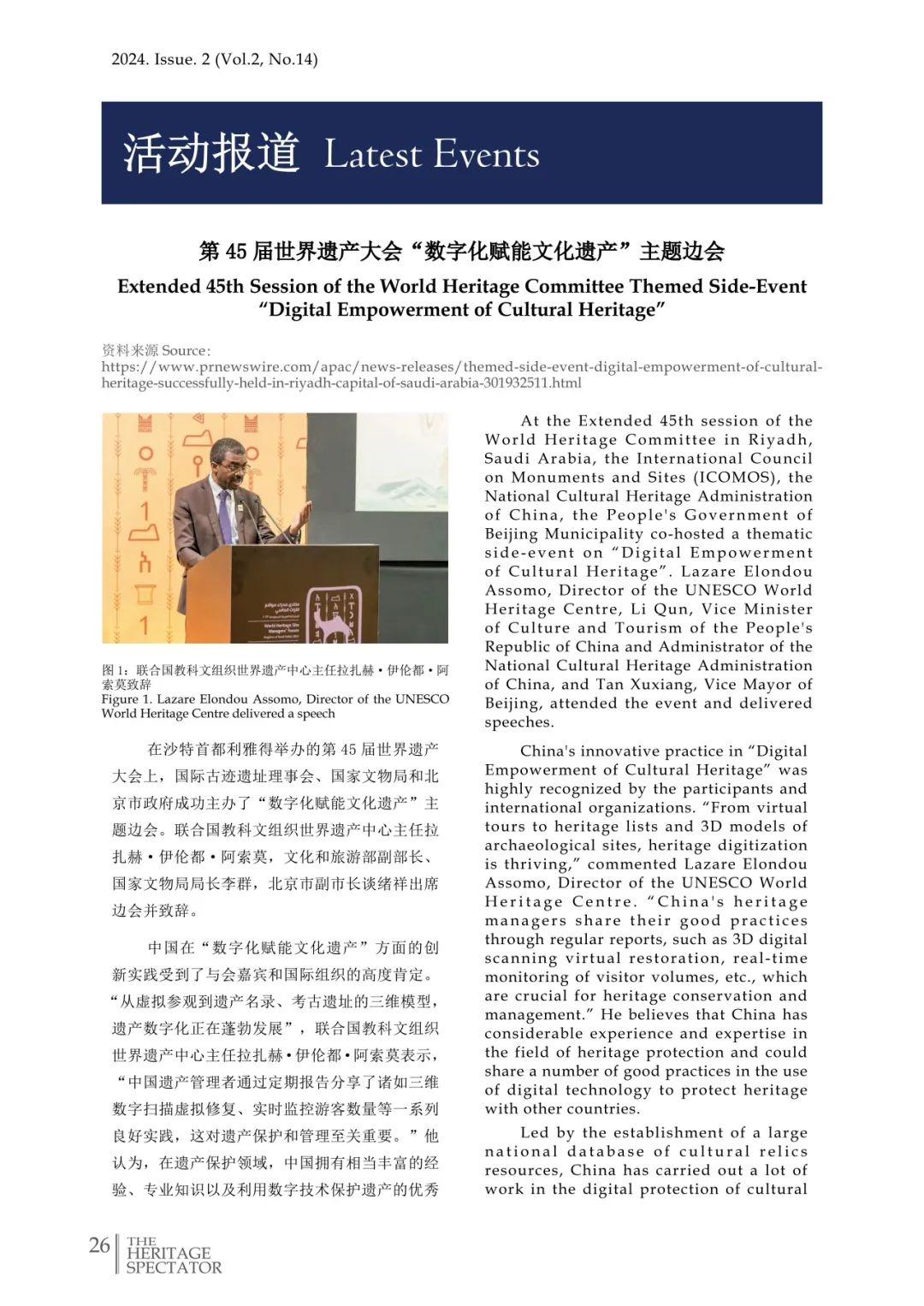联合实验室中英双语双月刊《遗产研究国际动态》(内刊)2024年第二期(总第十四期)已发布,全刊内容可在此下载
![]() JLBRI国家“一带一路“联合实验室《遗产研究国际动态》总第十四期The Heritage Spectator No.14.pdf
JLBRI国家“一带一路“联合实验室《遗产研究国际动态》总第十四期The Heritage Spectator No.14.pdf
前沿研究
数字技术与遗产保护
数字技术是利用激光扫描、无人机、数字摄影、地理信息系统(GIS)、人工智能(AI)等技术进行建筑遗产保护的有效手段之一。数字建模、激光扫描、身临其境和增强现实、移动应用程序、虚拟平台、展览和遗址游览等为实体遗产的保护、解释和欣赏提供了数字替代方式,特别是在遗产面临消失风险或已经受到冲突、气候变化、灾害和 / 或其他有害事件破坏的情况下。
创新的数字工具和方法可以为博物馆、遗产地保护者和管理者、政府机构、学术机构、社区和其他利益相关者提供实体遗产保护和享受的数字替代方案,同时提高遗产意识和可及性。
随着数字技术的发展和普及,一些国家开展了建筑遗产数字化保存的研究和实践。建筑遗产数字化保护研究领域由四个组集群组成:建模、文化遗产、管理和建筑。这些集群涵盖了建筑遗产保护的不同方面,如灾害分析、建模、数据管理和遗产保护,并说明了数字技术在建筑遗产保护各阶段的应用,其中涉及数据采集、数字化保存和数字应用。
Digital Technology and Architectural Heritage Conservation
Digital Technology is one of the effective means in architectural heritage conservation by using laser scanning, drones, digital photography, Geographic Information System (GIS), Artificial Intelligence (AI), and other technologies. Digital modelling, laser scanning, immersive and augmented reality, mobile apps, virtual platforms, exhibitions and site tours, for example, offer digital alternatives to physical heritage conservation, interpretation and enjoyment, particularly in contexts where heritage is at risk of disappearance or has already been damaged by conflict, climate change, disasters and/or other harmful events.
Innovative digital tools and approaches can provide museums, heritage site conservators and managers, governmental bodies, academic institutions, communities and other stakeholders with digital alternatives to physical heritage preservation and enjoyment, also increasing heritage awareness and accessibility.
With the development and popularity of Digital Technology, some countries carried out research and developed practices in relation to the digital preservation of architectural heritage. The research field of the digital preservation of architectural heritage consists of four clusters: Modeling, Cultural Heritage, Management and Architecture. These clusters cover different aspects of architectural heritage conservation, such as disaster analysis, modeling, data management, and heritage conservation, and illustrate the application of Digital technology in various stages of architectural heritage conservation under disaster conditions, which involve digital recording, digital preservation and digital applications.
资料来源:
A review of the tools and techniques used in the digital preservation of architectural heritage within disaster cycles.
Brief Report from the UK National Commission for UNESCO and PRAXIS: using digital technologies to innovate in heritage research, policy and practice.
实践案例
复杂历史遗址的三维重建:佛罗伦萨奥桑米歇尔教堂
数字人文项目“ 曾经的佛罗伦萨”旨在通过将建筑物(即现存结构,如小礼拜堂、教堂等)的三维点云模型与 14、15世纪建筑物内部的艺术品的三维渲染模型相结合,重现中世纪晚期和现代早期建筑物的建筑和装饰。从意大利佛罗伦萨奥桑米歇尔教堂的案例研究中可以看到这项工作的流程。
奥桑米歇尔教堂位于佛罗伦萨市中心的卡尔齐奥利大道(Via dei Calziauoli)沿线,这里是连接城市中心和精神中心(大教堂和洗礼堂)的主要城市大道。这座三层楼高的长方形建筑最初是一座修道院,十三世纪中叶被改建为谷仓。1304 年,一名纵火犯的劣行导致了奥桑米歇尔教堂在大火中损毁,但教堂很快得到了重建,可能早在 1315 年就得到了重建。1336 年,这座建筑被改建成了一座教堂,佛罗伦萨的 21 个行会承诺支持这座教堂,并委托创作虔诚的艺术品作为教堂内外的装饰。
十四世纪期间,许多绘画作品被设计并安置在作为建筑物基础的十二个墩柱上。佛罗伦萨的行会安排当地画家围绕着创造奇迹的圣母与圣婴画像为他们的守护神绘制肖像。其中最早的圣巴塞洛缪像是由一位名叫雅各布·德尔·卡森蒂诺(Jacopo del Casentino)的艺术家绘制的,并于 1340 年左右安放在奥桑米歇尔教堂 (Orsanmichele)。此后几十年间,教堂内陆续增添了多幅绘画作品。奥桑米谢尔教堂内的十二个墩柱几乎每一面都安装了一个装饰的画作,以纪念某个行会的守护神。到了1409年,为了让一位名叫尼科洛·迪·彼得罗·杰里尼 (Niccolò di Pietro Gerini) 的艺术家可以在墩柱的壁龛中为这些人物绘制壁画,原有装饰的画作被分开拆除了。因此,奥桑米歇尔内部的原始装饰物被这些新的添加物改变了。
尽管奥桑米歇尔的建筑仍然矗立着,尽管圣母与圣婴像未被移走,但这座由谷仓改建的教堂内原有装饰的其余部分都被剥离了。散佚的画作现在保存在大西洋两岸的艺术博物馆中,他们既不能在原有的场景中被看到,也不能与奥桑米歇尔教堂中的其他画作产生任何关联。作为欧洲最重要的中世纪中心之一,理解其形式与功能是文化历史学家的工作,而画作的分散使这项工作变得异常困难。重现这个空间的原始形态的唯一方法是创建一个混合模型,将建筑空间的重建与原本安置其中的艺术品模型结合在一起。
A 3D reconstruction of complex historic sites: the church of Orsanmichele,Florence
The Digital Humanities project Florence As It Was (https://florenceasitwas.wlu.edu) seeks to reconstruct the architectural and decorative appearance of late Medieval and early Modern buildings by combining 3D point cloud models of buildings (i.e. extant structures such as chapels, churches, etc.) with 3D rendered models of artworks that were installed inside them during the fourteenth and fifteenth centuries. An example of this workflow may be seen in the case study of Orsanmichele, a church in the center of Florence, Italy.
The church of Orsanmichele is located in the center of Florence along the Via dei Calziauoli, a major urban avenue that links the civic center of cityto its spiritual center (the cathedral and baptistery). Originally used as a monastery, the three-story rectangular building was converted into a grain loggia in the middle of the thirteenth century. An arsonist’s rage resulted in the destruction of the structure in the fire of 1304, but Orsanmichele was quickly rebuilt, probably as early as 1315. In 1336 the building was refashioned into a church, with the twenty-one guilds of Florence pledging to support it by commissioning devotional artworks to decorate its interior and exterior.
During the fourteenth century, a number of panel paintings were produced and installed on the twelve piers that serve as the building’s foundation. The guilds of Florence arranged for local painters to produce effigies of their patron saints to surround the miracle working painting of the Madonna and Child (Fig. 3). The earliest of these, dedicated to the figure of Saint Bartholomew, was painted by an artist named Jacopo del Casentino and installed in Orsanmichele sometime around the year 1340. Several paintings were installed inside the in the church one after the other in the next decades. Nearly every side of the twelve piers inside the church of Orsanmichele held one of these dossal panels dedicated to a guild’s patron saint. By 1409 each of these panels had been removed and dispersed to allow an artist named Niccolò di Pietro Gerini to paint frescoes of these same figures in niches that were carved into the piers. The original decorative program of Orsanmichele’s interior was therefore altered by these new additions.
Although the building of Orsanmichele still stands, and although the tabernacle and cult image of the Madonna and Child have never been moved from it, the remainder of the original decorative program inside the granary- turned-church has been stripped away forever. The dossal panels that have survived, now maintained in art museums on either side of the Atlantic Ocean, can be seen in neither their intended setting nor in relation to the other dossal panels that joined them in the open space of Orsanmichele. This dispersal of imagery makes the cultural historian’s job of understanding the form and function of one of Europe’s most important medieval centers unusually difficult. The only way to see the appearance of this space as it was originally conceived is to create a hybrid model that fuses a reconstruction of the architectural space with models of the artworks that were intended to be seen there.
资料来源:
A practical workflow for the 3D reconstruction of complex historic sites and their decorative interiors: Florence As It Was and the Church of Orsanmichele
https://florenceasitwas.wlu.edu
平台动态
基于文化评价的贾家崖文化公园营建策略研究
随着社会发展,城市面临文化空间载体不足,文化景观雷同等问题,而文化公园作为可以综合本土文化、城乡产业、居民就业、提高基础设施与公共服务设施建设水平,对展示特色文化、释放乡村活力具有极大的推动作用。
贾家崖村地处关中平原西端,宝鸡市中心以东、陈仓区东部区域。村址向西比邻虢镇街道,朝向宝鸡市中心,向东、向北靠近阳平镇、周原镇、慕仪镇,朝向宝鸡传统的乡村地区,拥有者丰富的地域文化。政策上,继国家“十四五”规划等政策文件提出后,宝鸡市人民政府、文化和旅游局以及陈仓区政府先后提出《国民经济和社会发展第十四个五年规划和二〇三五年远景目标纲要》、《宝鸡市打造千亿级文化旅游产业实施意见》、《关于印发宝鸡市陈仓区创建国家文化和旅游消费试点城市工作方案的通知》等文件,明确提出了要携手乡村振兴推进“文旅 +”,打造宝鸡旅游特色产品的政策条目。
研究在对贾家崖村落周边文化多次考察的基础上,将专家打分法和 AHP 层次分析法、模糊综合评价法相结合,在建立对所选文化设施建设、文化认同度、文化参与度等方面的感性、理性认识的基础上,对贾家崖村落周边文化进行定量、定性评估,以客观地筛选可以转化运用的文化类别。
Research on construction strategy of Jiajiaya Cultural Park based on cultural evaluation
With the development of society, cities are faced with the problems of insufficient cultural space carriers and the similarity of cultural landscapes. Cultural parks can integrate local culture, urban and rural industries, residents' employment, improve the construction level of infrastructure and public service facilities, and play a great role in promoting the display of characteristic culture and the release of rural vitality.
Jiajiaya Village is located at the west end of Guanzhong Plain, east of Baoji City center and east of Chencang District. The village site is adjacent to the street of Guo Zhen to the west, toward the center of Baoji, toward the east and north of Yangping Town, Zhouyuan Town and Muyi Town, toward the traditional rural area of Baoji, and has a rich regional culture. In terms of policy, following the national 14th Five-Year Plan and other policy documents, Baoji Municipal People's Government, the Culture and Tourism Bureau and the Chencang District Government have successively put forward the 14th Five-Year Plan for National Economic and Social Development and the Outline of 2035 Vision Goals, the Implementation Opinions of Baoji City to build a 100-billion-level cultural Tourism Industry, and the Notice on printing and distributing the Work Plan of Chencang District of Baoji City to create a National Cultural and Tourism Consumption Pilot City. Clearly put forward to join hands in rural revitalization to promote cultural tourism +, to create Baoji tourism characteristic products policy items.
On the basis of several visits to the surrounding culture of Jiajiaya Village, the study combined the expert scoring method, AHP analytic hierarchy process and fuzzy comprehensive evaluation method, and carried out quantitative and qualitative assessment of the surrounding culture of Jiajiya village on the basis of establishing the perceptual and rational understanding of the selected cultural facilities construction, cultural recognition and cultural participation. In order to objectively screen the cultural categories that can be transformed and applied.
活动报道
第 45 届世界遗产大会“数字化赋能文化遗产”主题边会
在沙特首都利雅得举办的第 45 届世界遗产大会上,国际古迹遗址理事会、国家文物局和北京市政府成功主办了“数字化赋能文化遗产”主题边会。联合国教科文组织世界遗产中心主任拉扎赫·伊伦都·阿索莫,文化和旅游部副部长、国家文物局局长李群,北京市副市长谈绪祥出席边会并致辞。
中国在“数字化赋能文化遗产”方面的创新实践受到了与会嘉宾和国际组织的高度肯定。“从虚拟参观到遗产名录、考古遗址的三维模型,遗产数字化正在蓬勃发展”,联合国教科文组织世界遗产中心主任拉扎赫·伊伦都·阿索莫表示,“中国遗产管理者通过定期报告分享了诸如三维数字扫描虚拟修复、实时监控游客数量等一系列良好实践,这对遗产保护和管理至关重要。”
21 世纪那不勒斯文化遗产大会
21世纪那不勒斯文化遗产大会于 2023年11月 27-29日在意大利那不勒斯举行。会议由联合国教科文组织、意大利外交与国际合作部及意大利文化部共同组织,并得到那不勒斯市的支持。
会议适逢《世界遗产公约》(1972 年)成立 50 周年和《保护非物质文化遗产公约》(2003年)成立 20 周年,会议探讨了二者间的协同作用。
作为世界文化政策与可持续发展会议之后首次将《世界遗产公约》和《活态遗产公约》汇集在一起的重大活动,本次会议强调了遗产形式的多样性,旨在通过积极的社区参与加强并更新遗产保护形式。会议回顾了这两项公约所取得的成就,并围绕遗产作为可持续发展、和平与稳定的潜在动力这一议题展开讨论。
城乡遗产保护与创新“雁塔”论坛
2023 年 12 月 2 日,由中国 - 葡萄牙文化遗产保护科学“一带一路”联合实验室、长安大学建筑学院联合承办的“城乡遗产保护与创新‘雁塔’论坛”顺利举行。
本次论坛旨在进一步发挥基地在科研和教学中的促进作用,通过专家和研究生的共同参与,促进更广泛的思维碰撞和学术合作,推动城乡遗产保护与创新领域不断进步。
主旨报告环节共邀请 10 位专家学者发表学术演讲,聚焦历史文化名城的保护与利用、考古遗址利用与展示,古建筑测绘与修复等重大问题进行经验分享。
Extended 45th Session of the World Heritage Committee Themed Side-Event Digital Empowerment of Cultural Heritage
At the Extended 45th session of the World Heritage Committee in Riyadh, Saudi Arabia, the International Council on Monuments and Sites (ICOMOS), the National Cultural Heritage Administration of China, the People's Government of Beijing Municipality co-hosted a thematic side-event on Digital Empowerment of Cultural Heritage. Lazare Elondou Assomo, Director of the UNESCO World Heritage Centre, Li Qun, Vice Minister of Culture and Tourism of the People's Republic of China and Administrator of the National Cultural Heritage Administration of China, and Tan Xuxiang, Vice Mayor of Beijing, attended the event and delivered speeches.
China's innovative practice in Digital Empowerment of Cultural Heritage was highly recognized by the participants and international organizations. From virtual tours to heritage lists and 3D models of archaeological sites, heritage digitization is thriving. commented Lazare Elondou Assomo, Director of the UNESCO World Heritage Centre. China's heritage managers share their good practices through regular reports, such as 3D digital scanning virtual restoration, real-time monitoring of visitor volumes, etc., which are crucial for heritage conservation and management. He believes that China has considerable experience and expertise in the field of heritage protection and could share a number of good practices in the use of digital technology to protect heritage with other countries.
The Naples Conference on Cultural Heritage in the 21st Century
The Naples Conference on Cultural Heritage in the 21st Century is hosted from 27-29 November 2023 in Naples, Italy, and organized by UNESCO, in cooperation with the Italian Ministry of Foreign Affairs and International Cooperation and the Italian Ministry of Culture, with the support of the City of Naples.
The Conference explores synergies between the 1972 World Heritage Convention, which celebrated its 50th anniversary last year, and the 2003 Convention for the Safeguarding of the Intangible Cultural Heritage marking its 20th anniversary this year.
As the first major event bringing together the World Heritage and Living Heritage Conventions following MONDIACULT, this Conference celebrates heritage in its diverse forms, fostering enhanced and new forms of safeguarding through active participations of communities. Reflecting on the achievements of the two Conventions, discussions center around the potential of heritage as a driver of sustainable development, peace and stability.
The “Wild Goose Pagoda” Forum on Urban and Rural Heritage Conservation and Innovation
On December 2, 2023, the “ ‘Wild Goose Pagoda’ Forum on Urban and Rural Heritage Conservation and Innovation” co-organized by the China-Portugal Joint Laboratory of Cultural Heritage Conservation Science supported by the Belt and Road Initiative (JLBRI) and the School of Architecture, Chang’an University was successfully held. The opening ceremony was moderated by Chen Wenliang, Deputy Head of Xi'an Research Base of JLBRI and Director of Urban and Rural Planning Department of School of Architecture, Chang'an University.
The forum aimed to advance its role in promoting scientific research and teaching, achieve a broader collision of ideas and academic cooperation through the joint participation of experts and postgraduates, and promote sustainable progress in urban and rural heritage conservation and innovation.
The keynote report session invited 10 experts and scholars to deliver speeches on major issues including the conservation and utilization of historical and cultural cities, the utilization and display of archaeological sites, and the mapping and restoration of ancient buildings.
资料来源:
https://www.prnewswire.com/apac/news-releases/themed-side-event-digital-empowerment-of-cultural-heritage-successfully-held-in-riyadh-capital-of-saudi-arabia-301932511.html
https://www.unesco.org/en/articles/koh-ker-highlighted-model-cultural-heritage-management-peacebuilding-naples-conference-cultural
https://www.unesco.org/en/culture/naples-conference
中国-葡萄牙文化遗产保护科学“一带一路”联合实验室西安研究基地

